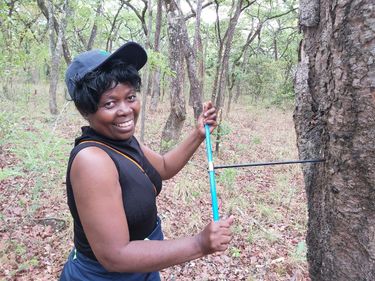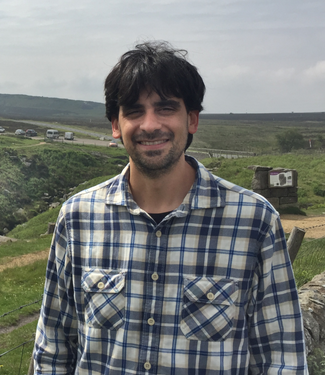
Sessions in which Emily Reid participates
Monday 27 June, 2022
Blue Intensity (BI) is a cost-effective analytical method for measuring relative wood density in the rings of conifer tree species. Since early concept papers in the 1990s/2000s, there has been a recent explosion in the application of this method for both dendroclimatology and historical dating as well as other dendro-disciplines. The beauty of BI is that the analytical costs, mainly related to the cost of a h...
Blue Intensity (BI) is a cost-effective analytical method for measuring relative wood density in the rings of conifer tree species. Since early concept papers in the 1990s/2000s, there has been a recent explosion in the application of this method for both dendroclimatology and historical dating as well as other dendro-disciplines. The beauty of BI is that the analytical costs, mainly related to the cost of a h...
Wednesday 29 June, 2022
The classic definition of the so-called “divergence problem” is a decoupling of temperature sensitive tree-ring chronologies from the instrumental record – expressed either as a loss or weakening in the inter-annual signal, or a divergence in trend in the recent period. Western Canada is one such area where divergence is ostensibly prevalent. However, recent observations using ring-width (RW) and latewood blue intensity (LWB) parameters challenge our views on divergence in this region: tre...
Sessions in which Emily Reid attends
Monday 27 June, 2022
Meet colleagues and friends in an informal settingFree drinks for all!
Tuesday 28 June, 2022
Africa is faced with a number of challenges including climate change and ecological disturbance due to various anthropogenic activities. These problems adversely affect the forests and also ecosystem services. My appreciation for the forests motivated me to pursure my undergraduate studies in Forestry. I first applied dendrochronology during my PhD research which focused on understanding the climate change vulnerability of the Zambezi teak forests in Zambia. However, lack of research facil...
"Emerging in the early 20th century, the scientific study of tree-rings has a rich but under-cultivated history. This project reviews the historiography (or the history of historical writing) of dendrochronology. From the pioneering work of A.E. Douglass and others to the establishment of institutions dedicated to advancing dendrochronology by the 1950s, the field has secured its place as an ensemble of techniques to interpret tree rings, with applications in archeology, climatology, ecolo...
Ultra high resolution imaging is becoming standard across the sciences and must be a priority for dendrochronology. Large format scanners fail to resolve micro rings and the anatomical structures of increasing scientific interest. Meanwhile, current software limitations include cost, user experience, data management flexibility, and capacity for handling large file sizes. We argue for a new paradigm and present a technology framework that integrates gigapixel macro photography, a cloud-hos...
As of 2020, 56% of the world’s population live in urban areas. These individuals benefit from numerous ecosystem services provided by urban forests, including urban heat island mitigation, energy use reduction, stormwater interception, wildlife and pollinator habitat provision, air pollution removal, and carbon sequestration. Urban greenspaces are also often the most accessible avenue for exposure to the natural environment, providing additional aesthetic, recreati...
Wednesday 29 June, 2022
Dendrochronology is considered one the most precise of all the scientific dating techniques. However, it requires long sequences of tree rings and a master record for both the species and region in question. At the University of Groningen, we have been pioneering a new approach to dating that combines the precision of dendrochronology with the versatility of radiocarbon dating. It relies on the detection of spikes in the annual radiocarbon record, thought to b...
Information garnered from historical timbers and wooden artifacts (e.g. houses, barns, ships) can greatly enhance our understanding of human, ecological, and climate history, especially in regions where few old-growth forests and trees remain, tree longevity is relatively short (less than 300-400 years), and environmental conditions break down wood rather quickly, like in mesic to wet regions. Over the last decade plus, the application of tree-ring techniques on wo...
Forty years ago Dr. Tom Yanosky, a research botanist with the US Geological Survey, reported that ash trees growing along the Potomac River contained rings with abnormal wood anatomy caused by flood damage. Dr. Yanosky recommended these rings — which he dubbed “flood rings” — could be used to estimate the date, seasonal timing, and (most importantly) peak stage of past floods. Since that discovery, flood rings have been identified for forested river systems in eastern France, central Canad...
Coastal maritime forests in northeastern USA are mostly fragmented and currently threatened by climate change. This study focuses on American holly (Ilex opaca) trees located in the coastal maritime forests of Sandy Hook, N.J. and Fire Island, N.Y. to better understand how vulnerable and resilient these forests are to future climate scenarios. There are few published studies that use tree-ring methods in the maritime forests of N.J. and dendrochronological research on holly species has jus...
Dendrochronology in eastern New York State, USA, was established from timbers used in European settlement and development of the Hudson and Mohawk River Valleys starting in the mid-17th century. The abundant primary forests were the source, and timbers were used locally and exported via the rivers. West of the Hudson River Valley, successful settlement was more precarious from human conflict until the late 18th - early 19th century, and the oldest dated buildings are located al...
Dendroclimatological reconstructions are often extended into the past with wood from historical buildings. However, the varying, though frequently unknown origin of timbers not only affects the growth rate but also the climate response of individual tree-ring samples. We tested nine supervised machine learning algorithms for the geographical provenancing of 99 historical tree-ring samples. We sampled 143 living larch (Larix decidua Mill) trees at seven sites along an elevational gradient f...
This is a mandatory (!) .... and FREE (!!) cocktail & award ceremony (!!!)(in replacement of the Banquet formula)->->->->->->->->->->->->->->->->->->After a great summer day of scientific and urban discoveries in our beloved MTL, we wish to bring together all the AmeriDendro community in one place and congratulate the TRS awardees for their remarkable achievements! -Bonsinsegna award-Fr...
Thursday 30 June, 2022
How old are tropical trees? This fundamental question has long driven the curiosity of laymen and scientists. But only recently, a great number of studies conducted by many brave dendrochronologists resulted in a significant tree-ring-based knowledge that allows us to start accurately estimating tree ages across the globe. As science goes, not only knowing the longevity of tropical trees is essential to understanding forest dynamics and its role in biogeochemical cycles, but one must also ...
The assessment of pre-instrumental climate variability during the Common Era (CE) has been a key element of IPCC reports and was recently emphasized by showing a single temperature reconstruction as the first figure in the 2021 Summary for Policymakers (SPM). This reconstruction is derived from dozens of proxy records including tree-rings, corals, ice cores and sediments, and displays the course of global temperatures over the past 2000 years. Show casing a single study for paleoclimate co...
"Maximum latewood density (MXD) is the most sensitive proxy for reconstructing temperature variations over past centuries to millennia. However, the development of long MXD chronologies has lagged far behind that of ring width chronologies, especially in North America. Among a handful of millennial MXD records across the northern hemisphere, only a few are from North American sites.In this study, we fill this data gap by developing a millennial MXD data network from an unprecedented...
In tropical environments of central America, tree-ring forming species are rare to find, especially in areas with pronounced aseasonality, but wood anatomical traits can equally provide important information on species life-histories and response to disturbances. Dating wood anatomical structures remains a crucial task to decipher the ecological information recorded in xylem cellular parameters in absence of defined ring boundaries, particularly to observe the footprint of discrete disturb...
Tree-ring records have been used extensively to reconstruct past streamflow variability. Annually resolved estimates for several centuries prior to observations, and in some cases millennia, have been produced from dendroclimatic proxies. However, despite an often strong hydroclimatic signal embedded in the rings, some factors limit the skill of such reconstructions, including human interference with the hydrological cycle. We examine the relationship between local output...
Given the short span of instrumental hydroclimatic records in the South American Altiplano, longer time records are needed to understand the nature of climate variability and to improve the predictability of precipitation, a key factor modulating the socio-economic development in the Altiplano and adjacent arid lowlands. In this region growths P. tarapacana, a long-lived tree species being very sensitive to hydroclimatic changes and widely used for tree-ring studies in central and southern...
The most biodiverse region in the world can be found in the tropical Andes (~5º-24ºS) between Venezuela and the Bolivian Altiplano, yet it is highly under-sampled in dendrochronology in part due to the prevalence of trees without rings (continuous growth) and the overall hyperdiversity of the ecosystems. The Madidi National Park (MNP) in northern Bolivia. (~14 ºS, -68°W) is a biodiversity hotspot with lowland rainforests and high montane environments that provide unique opportunities for t...
Araucaria angustifolia is an endangered species that occurs in the high and cold regions of southern Brazil. This species has economic importance due to its wood and seeds, as well as playing a fundamental ecological role for the southern fauna and flora. Climate change can affect it sdistributional area and conservation, making it urgent to investigate the effect of climate on its development. The objective of our study was to investigate how growth rates of A. angustifolia vary in relati...
Neogene fossil beds in the Canadian Arctic Archipelago (CAA) provide a window into past greenhouse intervals and insights on what a future, warmer Arctic may look like. In this study, we use the hydrogen isotopes of lignin-methoxy groups (δ2HLM) from sub-fossil wood from six CAA sites (73-80°N) as a proxy for the δ2H of precipitation-derived plant water and paleotemperatures; five study sites cover Pliocene timeslices (~5.3-2.6 Ma) and the other site captures the middle Miocene (~15 Ma). F...
The Caribbean, like much of the tropics, is underrepresented by tree-ring chronologies making global climate reconstructions a challenge because of these blind spots. We have developed a multi-centennial tree-ring chronology from 120 samples of Pinus occidentalis trees located above 2800 m elevation on the dry slopes of Loma la Pelona in the Cordillera Central (19.035278 N, -71.005278 W) of the Dominican Republic. We used skeleton plotting on multiple radii from each crossection to date th...
A gap of millennial tree-ring data suitable for dendroclimatology has long been evident in the North American boreal forest. In my talk, I will describe the adaptive approach we have developed to build and improve a data network for millennial dendroclimatology in the eastern Canadian taiga. Recurrence of stand replacing wildfires is the most important constrain to the elaboration of long tree ring chronologies, which can only be developed away from regions ...
The interpretation of stable isotopes in a dendroecological framework can provide powerful insights into how trees adjust physiologically in response to the environment. This symposium aims to bring together researchers who use stable isotopes in tree rings to address ecophysiological responses to environmental changes from intra-annual to multi-decadal resolution. We hope this symposium will enable fruitful discussions and new ideas a...
Drought conditions have been projected to increase globally as atmospheric CO2 (ca) and vapor pressure deficit (VPD) increase. Experimental and modelling studies have suggested that forest responses to drought may be bolstered by increased ca, but it remains unclear how prevalent this response is in natural forest ecosystems. We developed a framework using intrinsic water use efficiency (WUEi = assimilation (A)/ stomatal conductance (gs)) and evaporative water use efficiency (WUEE = A/tran...
The boreal forest located in high northern latitudes stores about a third of the world’s carbon and covers almost a quarter of the Earth’s land surface. This region is experiencing one of the fastest temperatures increases on the planet. Yet it is unclear how global warming affects carbon sequestration and storage in this biome. Here, we explore how white spruce (Picea glauca [Moench] Voss) growing in North America responded to climate change during the 20th century using tree-ring width a...





